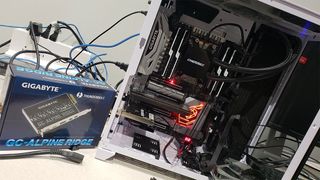Complex Threadripper hack gets Intel's Thunderbolt 3 working on AMD hardware
It's technically possible to enable Thunderbolt on a Threadripper platform.

Gigabyte had grand plans of enabling Thunderbolt 3 support on its X399 Designare EX motherboard by way of an add-in card, which users could buy and plug into a header. There was only one problem—Thunderbolt is proprietary Intel technology, and Intel hasn't certified any implementations on Ryzen or Threadripper. We don't know the full situation, but the roadblock appears to be more of a licensing issue than a technical one.
"Thunderbolt 3 certification requires a few things from the CPU side like graphical output which we haven't been able to do. We expect this will be developed upon through Raven Ridge and possibly get more groundwork down to activate TB3 on the X399 Designare EX," Gigabyte told Anandtech in September 2017.
Fast forward to now and Thunderbolt still is not available on any Ryzen or Threadripper motherboards that we are aware of. However, Wendell Wilson at Level1 Techs posted a video over the weekend showing that it can work, with some fancy coding. It also requires plucking the firmware chip from an Intel motherboard.
"I got it working and it took reverse engineering, poking at things, and doing a lot of unholy stuff. This is not sanctioned by anybody, I did not have help from anybody," Wendell explains.
Unfortunately, he is not able to share the full details for fear of legal repercussions from Intel. But he did get it to work without any major issues, albeit without hot plug support. That's a bit more challenging, apparently.
Enabling Thunderbolt 3 support on Threadripper would allow users to plug in an external GPU, though as Wendell notes in his video, that does not really make a whole lot of sense. What is potentially more useful is plugging in an external PCIe storage device.
As Wendell explains, there is less of a bottleneck for Thunderbolt on Threadripper, compared to Intel systems. In theory, you could have an NVMe drive inside the PC and another one connected external, both with their own dedicated connection to the CPU (through the add-in card). In a RAID 0 array, you could be looking at 6-7GB/s, depending on the drives.
The biggest gaming news, reviews and hardware deals
Keep up to date with the most important stories and the best deals, as picked by the PC Gamer team.
Here's the video:
Paul has been playing PC games and raking his knuckles on computer hardware since the Commodore 64. He does not have any tattoos, but thinks it would be cool to get one that reads LOAD"*",8,1. In his off time, he rides motorcycles and wrestles alligators (only one of those is true).
Most Popular





